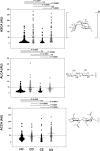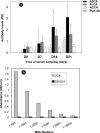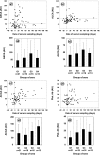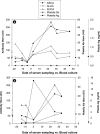Antibodies against glucan, chitin, and Saccharomyces cerevisiae mannan as new biomarkers of Candida albicans infection that complement tests based on C. albicans mannan
- PMID: 18971303
- PMCID: PMC2593178
- DOI: 10.1128/CVI.00200-08
Antibodies against glucan, chitin, and Saccharomyces cerevisiae mannan as new biomarkers of Candida albicans infection that complement tests based on C. albicans mannan
Abstract
Antibodies against Saccharomyces cerevisiae mannan (ASCA) and antibodies against synthetic disaccharide fragments of glucans (ALCA) and chitin (ACCA) are biomarkers of Crohn's disease (CD). We previously showed that Candida albicans infection generates ASCA. Here, we explored ALCA and ACCA as possible biomarkers of invasive C. albicans infection (ICI). ASCA, ALCA, ACCA, and Candida mannan antigen and antibody detection tests were performed on 69 sera obtained sequentially from 18 patients with ICIs proven by blood culture, 59 sera from CD patients, 47 sera from hospitalized subjects colonized by Candida species (CZ), and 131 sera from healthy controls (HC). ASCA, ALCA, and ACCA levels in CD and ICI patients were significantly different from those in CZ and HC subjects (P<0.0001). In ICI patients, these levels increased as infection developed. Using ASCA, ALCA, ACCA, and Platelia Candida tests, 100% of ICIs were detected, with the kinetics of the antibody response depending on the patient during the time course of infection. A large number of sera presented with more than three positive tests. This is the first evidence that the detection of antibodies against chitin and glucans has diagnostic value in fungal infections and that these tests can complement more specific tests. Future trials are necessary to assess the value of these tests in multiparametric analysis, as well as their pathophysiological relevance.
Figures




Similar articles
-
Candida albicans is an immunogen for anti-Saccharomyces cerevisiae antibody markers of Crohn's disease.Gastroenterology. 2006 May;130(6):1764-75. doi: 10.1053/j.gastro.2006.02.009. Gastroenterology. 2006. PMID: 16697740
-
Candida albicans colonization and ASCA in familial Crohn's disease.Am J Gastroenterol. 2009 Jul;104(7):1745-53. doi: 10.1038/ajg.2009.225. Epub 2009 May 26. Am J Gastroenterol. 2009. PMID: 19471251
-
Detection of antisynthetic mannoside antibodies (ASigmaMA) reveals heterogeneity in the ASCA response of Crohn's disease patients and contributes to differential diagnosis, stratification, and prediction.Am J Gastroenterol. 2008 Apr;103(4):949-57. doi: 10.1111/j.1572-0241.2007.01648.x. Epub 2007 Nov 28. Am J Gastroenterol. 2008. PMID: 18047546
-
[Anti-glycan antibodies establish an unexpected link between C. albicans and Crohn disease].Med Sci (Paris). 2009 May;25(5):473-81. doi: 10.1051/medsci/2009255473. Med Sci (Paris). 2009. PMID: 19480828 Review. French.
-
From ASCA breakthrough in Crohn's disease and Candida albicans research to thirty years of investigations about their meaning in human health.Autoimmun Rev. 2024 Feb;23(2):103486. doi: 10.1016/j.autrev.2023.103486. Epub 2023 Nov 30. Autoimmun Rev. 2024. PMID: 38040100 Review.
Cited by
-
Modulation of intestinal inflammation by yeasts and cell wall extracts: strain dependence and unexpected anti-inflammatory role of glucan fractions.PLoS One. 2012;7(7):e40648. doi: 10.1371/journal.pone.0040648. Epub 2012 Jul 27. PLoS One. 2012. PMID: 22848391 Free PMC article.
-
Role of TLR1, TLR2 and TLR6 in the modulation of intestinal inflammation and Candida albicans elimination.Gut Pathog. 2017 Feb 15;9:9. doi: 10.1186/s13099-017-0158-0. eCollection 2017. Gut Pathog. 2017. PMID: 28289440 Free PMC article.
-
Lessons From Prospective Longitudinal Follow-up of a French APECED Cohort.J Clin Endocrinol Metab. 2025 Feb 18;110(3):e757-e773. doi: 10.1210/clinem/dgae211. J Clin Endocrinol Metab. 2025. PMID: 38605470 Free PMC article.
-
Dissection of the anti-Candida albicans mannan immune response using synthetic oligomannosides reveals unique properties of β-1,2 mannotriose protective epitopes.Sci Rep. 2021 May 24;11(1):10825. doi: 10.1038/s41598-021-90402-4. Sci Rep. 2021. PMID: 34031516 Free PMC article.
-
Understanding the Impact of Industrial Stress Conditions on Replicative Aging in Saccharomyces cerevisiae.Front Fungal Biol. 2021 Jun 2;2:665490. doi: 10.3389/ffunb.2021.665490. eCollection 2021. Front Fungal Biol. 2021. PMID: 37744109 Free PMC article. Review.
References
-
- Avron, B., R. M. Deutsch, and D. Mirelman. 1982. Chitin synthesis inhibitors prevent cyst formation by Entamoeba trophozoites. Biochem. Biophys. Res. Commun. 108:815-821. - PubMed
-
- Barnes, P. D., and K. A. Marr. 2007. Risks, diagnosis and outcomes of invasive fungal infections in haematopoietic stem cell transplant recipients. Br. J. Haematol. 139:519-531. - PubMed
-
- Breinig, F., K. Schleinkofer, and M. J. Schmitt. 2004. Yeast Kre1p is GPI-anchored and involved in both cell wall assembly and architecture. Microbiology 150:3209-3218. - PubMed
-
- Brown, G. D., and S. Gordon. 2003. Fungal beta-glucans and mammalian immunity. Immunity 19:311-315. - PubMed
-
- Calderone, R. A., and W. A. Fonzi. 2001. Virulence factors of Candida albicans. Trends Microbiol. 9:327-335. - PubMed
Publication types
MeSH terms
Substances
LinkOut - more resources
Full Text Sources
Other Literature Sources
Medical
Miscellaneous

